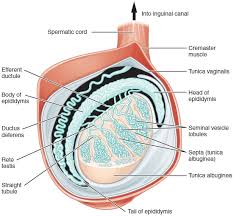Trace the path of sperm during ejaculation and mention the gland and their functions associated with the male reproductive system.
During ejaculation, sperm travels from the testicles through the epididymis, vas deferens, ejaculatory duct, and urethra. Along the way, seminal fluid is added from the seminal vesicles and prostate gland, creating semen. The bulbo-urethral gland contributes fluid that lubricates the urethra.
Here’s a more detailed breakdown:
1. Testicles:
Sperm are produced in the seminiferous tubules within the testicles.
Sperm then move through the rete testis and efferent ducts to the epididymis.
2. Epididymis:
Sperm mature and are stored in the epididymis.
3. Vas Deferens:
The vas deferens transports mature sperm from the epididymis to the ejaculatory duct.
4. Ejaculatory Duct:
The vas deferens joins with the seminal vesicle to form the ejaculatory duct.
The ejaculatory duct carries sperm and seminal fluid.
5. Urethra:
The ejaculatory duct empties into the urethra, which is a shared pathway for both urine and semen.
Glands and their functions:
Seminal Vesicles:
Produce approximately 60-65% of the seminal plasma, which contains fructose for sperm energy and prostaglandins to help with sperm transport and muscle contractions in the female reproductive tract.
Prostate Gland:
Contributes about 30% of the seminal plasma, which is alkaline to neutralize the acidic environment of the female reproductive tract and protect sperm.
Bulbo-Urethral Gland (Cowper’s Gland):
Produces a small amount of fluid (2-5% of seminal plasma) that lubricates the urethra before ejaculation.
